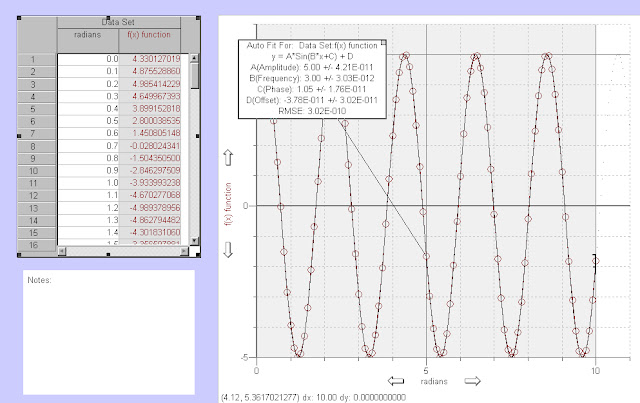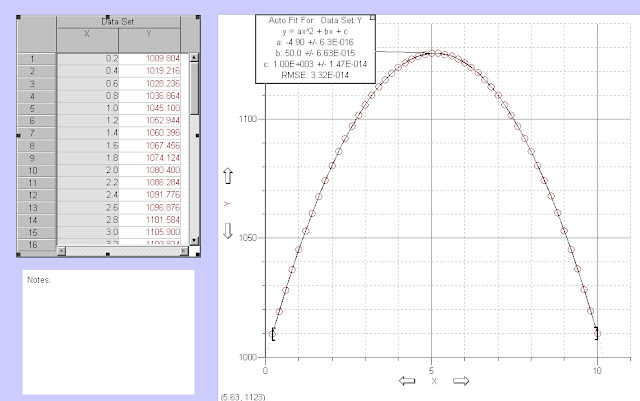The centripetal force apparatus (Pictured in Fig 1) is meant to rotate a known mass through a circular path of known radius. In timing the motion of the mass for a definite number of revolutions at roughly an equal linear speed, we can calculate the average speed. Because of the fact for uniform motion that;
 |
| Fig 1 |
a = V2/r
Where a =
acceleration, V = velocity, and r = radius
Then;
F = (mV2)/r
Where m = mass of object
Purpose:
The purpose of the Centripetal Force lab was to verify Newton's second law of motion, specifically for the case of uniform circular motion, which is stated as follows:
F = (mV2)/r
Centripetal force apparatus, metric scale, vernier caliper, stop watch, slotted weight set, weight hanger, and a triple beam balance.
Setup:
 |
| fig 2 |
Pictured in fig 2 is the centripetal force apparatus with its respective components.
Procedure:
Beginning the experiment, the apparatus is rotated at roughly a constant speed. In order to have roughly an equal speed of rotation, the mass must be passing directly over the vertical indicator as it revolves. In timing the time (s) it takes for the apparatus to be rotated 50 revolutions across the vertical indicator, the linear average velocity can be calculated. The circumference of the circle is used in order to calculate how the far object has traveled.
C = 2πr à
where r = radius = 0.1754m
C = 2π*0.1754 m
C = 1.1 m
Because we know that our object rotated 50 complete revolutions in the time period, then the total distance traveled is:
D = 50*C à
Where C = 1.1 m
D = 50*1.1 m
D = 55.1 m
From the first trial run performed with the mass of 0.5 kg, the time interval that the bulb traveled 55.1 m was 38.5 s. The average linear velocity is calculated as follows:
∆r/∆t=Vavg
55.1m/ 38.5s= Vavg
Vavg =
1.43 m/s
With this data, the centripetal force can be calculated with the formula given at the beginning of the lab:
F = (mV2)/r
FCalc
= (0.5 kg *1.43 m/s^2)/0.1754 m
FCalc
= 5.84 N
Pictured in fig 3 is the method that was taken in order to measure the amount of centripetal force. Because the spring is being stretched the same amount, the amount of force is equal. A known mass (g) was hung from a string off of the pulley in order to calculate the amount of force it takes to stretch the spring to where the bulb is directly over the vertical indicator. The mass that was measured was found to be 600 g, or 0.6 kg. The force in newtons is found as follows:
FMeas =
m*a
FMeas =
0.6 kg * 9.8 m/s2
FMeas =
5.88 N
Pictured below in fig 4 are the force diagrams for the forces acting both on the black bulb, as well as the mass hanging over the pulley. In both cases the net forces are zero, with no motion so all forces are balanced
 |
| fig 4 |
In taking the average calculated centripetal force from every trial and comparing with the result of the measurement, the amount of experimental error can be calculated. Because the average calculated centripetal force from the mass of 0.5 kg is 5.80 N, the experimental error is determined the following way:
100*((actual-calculated)/actual)
100*((5.88-5.80)/5.88)
=1.42% error
The entire process is then repeated for a new bulb mass of 0.6 kg simply by adding additional mass to the bulb.
Below in fig 5 and fig 6 are the data tables for each single trial run for bulb masses 0.5 kg as well as 0.6 kg.
 |
| fig 5 |
 |
| fig 6 |
 |
| fig 7 |
 |
| fig 8 |
Upon calculating the percentage error of the Newton's second law formula with the measured values, the results that were reached in this lab matched significantly. In the first trial run, the calculated value of centripetal force was found to be 5.84 N and the measurement was found to be 5.88 N. The difference was only 0.04 N which is arguably accurate. There were a few potential sources of error, for example:
1) The triple beam balance used was calibrated incorrectly
2) Although the bulb was passing over the vertical indicator, its position varied over each rotation. Certain times the bulb may have passed either few millimeters to the left or the right of the vertical indicator.
3) The stopwatch may not have been activated or deactivated in unison with the rotation of the bulb.











